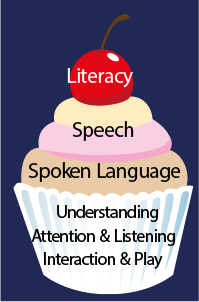Early speech and language skills are the most significant predictor of a child’s later literacy skills. Our spoken language skills are fundamental underpinnings of literacy because reading and writing are another medium for language. Developing confident readers and writers goes beyond phonics – we can boost literacy by building a good foundation of language skills. Here’s how:

Phonological Awareness
Children need to develop good phonological awareness skills to be able to identify and manipulate the sounds in words before they can write and recognise them. This skill is much broader than phonics, which refers to mapping sounds to letters, and includes segmenting sounds, blending sounds together, and recognising rhymes and syllable breaks.
Our tip: Make time to pause when you’re reading a book (or just looking at the pictures) so you can talk about the sounds in the words. Think about rhyme, syllable clapping or tapping, and listening to the first sound in words. Find groups of words which share one feature in common.
Inferencing
Reading requires more than simply decoding words. Children also need to understand what they have read. Children may need support to make links between events and to identify the intentions and motivations of characters. Without the extra information that is gleaned when we ‘read between the lines’, children won’t be able to understand the story and apply what they have learnt from a text in another context.
Our tip: When you’re reading with a child, pause to discuss what’s happening. Point out cause and effect situations and identify the emotions and motivations of characters to help children make links. See who can predict what might happen next.
Figurative Language
Good writing, whether it’s a story or a new report, uses figurative language to draw readers in and capture their imagination. Engaging features such as word-play, metaphors and idioms require an understanding of figurative or non-literal language and words with multiple meanings, or else they can quickly become very confusing.
Our tip: Make these unusual features of language explicit and take time to clearly explain the true meaning of figurative language. Encourage children to identify when they haven’t understood something, and check understanding by asking them to show or explain.
Vocabulary
Books can help to develop a child’s vocabulary outside of their everyday experiences, and as their vocabulary expands, they will become more and more able to work out the meaning of new words from context. Children with a limited vocabulary will find it difficult to make sense of texts and may struggle to engage in reading and writing activities.
Our tip: Make sure you explain any new vocabulary or concepts that you encounter. Remember – children need multiple exposures to new words to learn them securely. Props and actions can help to demonstrate meaning. Be sure to revisit new words and use them again in everyday contexts.
Language Structure
As well as recognising the words that make up a text, we need to understand and be able to use grammar and syntax effectively in order to make sense of what we are reading, and to write our ideas clearly and logically. Children will need to be able to understand and use grammatical features in spoken language before they are able to apply these skills to written language.
Our tip: Remember that you don’t have to read the words on the page. You can add in opportunities to use specific grammar. Use lots of opportunities to model target grammatical structures in spoken language and practise these with children.
Please login to view this content
Login